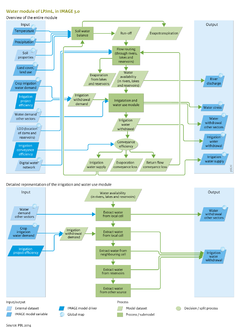Water: Difference between revisions
Jump to navigation
Jump to search
m (RinekeOostenrijk moved page Hydrological cycle to Water without leaving a redirect: Text replace - "Hydrological cycle" to "Water") |
m (Text replace - "Scenario drivers" to "Drivers") |
||
| Line 1: | Line 1: | ||
{{ComponentTemplate2 | {{ComponentTemplate2 | ||
|Application=OECD Environmental Outlook to 2050 (2012) project; | |Application=OECD Environmental Outlook to 2050 (2012) project; | ||
|IMAGEComponent= | |IMAGEComponent=Drivers; Agriculture and land use; Natural vegetation and carbon cycle; Crop and grass; Forest management; Human development; Energy supply and demand; | ||
|KeyReference=Rost et al., 2008; Gerten et al., 2004; Biemans et al., 2011; Biemans, 2012; | |KeyReference=Rost et al., 2008; Gerten et al., 2004; Biemans et al., 2011; Biemans, 2012; | ||
|Reference=OECD, 2012; Portmann et al., 2010; Fischer et al., 2005;Molden, 2007; FAO, 2011a; OECD, 2012; Sitch et al., 2003; Bondeau et al., 2007; | |Reference=OECD, 2012; Portmann et al., 2010; Fischer et al., 2005;Molden, 2007; FAO, 2011a; OECD, 2012; Sitch et al., 2003; Bondeau et al., 2007; | ||
Revision as of 17:50, 16 May 2014
| Component is implemented in: |
|
| Related IMAGE components |
| Projects/Applications |
| Key publications |
| References |
Key policy issues
- What is the combined effect of climate change and socio-economic development on water demand and availability, and on associated agricultural production?
- What is the potential of adaptation measures to reduce water stress and water-related crop production losses?
- How can water demand be reduced and still provide the adequate service levels to the sectors with the highest demand?
